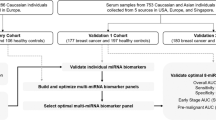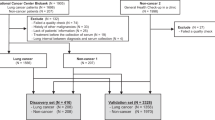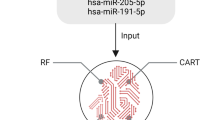Abstract
Early and precise cancer diagnosis substantially improves patient survival. Recent work has revealed that the levels of multiple microRNAs in serum are informative as biomarkers for the diagnosis of cancers. Here, we designed a DNA molecular computation platform for the analysis of miRNA profiles in clinical serum samples. A computational classifier is first trained in silico using miRNA profiles from The Cancer Genome Atlas. This is followed by a computationally powerful but simple molecular implementation scheme using DNA, as well as an effective in situ amplification and transformation method for miRNA enrichment in serum without perturbing the original variety and quantity information. We successfully achieved rapid and accurate cancer diagnosis using clinical serum samples from 22 healthy people (8) and people with lung cancer (14) with an accuracy of 86.4%. We envision that this DNA computational platform will inspire more clinical applications towards inexpensive, non-invasive and rapid disease screening, classification and progress monitoring.
This is a preview of subscription content, access via your institution
Access options
Access Nature and 54 other Nature Portfolio journals
Get Nature+, our best-value online-access subscription
$29.99 / 30 days
cancel any time
Subscribe to this journal
Receive 12 print issues and online access
$259.00 per year
only $21.58 per issue
Buy this article
- Purchase on Springer Link
- Instant access to full article PDF
Prices may be subject to local taxes which are calculated during checkout




Similar content being viewed by others
Data availability
The data that support the plots within this paper and other findings of this study are available from the corresponding author upon reasonable request. Furthermore, the miRNA-seq data used in this study are available on TCGA database https://portal.gdc.cancer.gov.
Code availability
The SVM training and validation code used in this study is from ref. 41 and available on https://www.csie.ntu.edu.tw/~cjlin/libsvm/.
References
Allemani, C. et al. Global surveillance of trends in cancer survival 2000-14 (CONCORD-3): analysis of individual records for 37 513 025 patients diagnosed with one of 18 cancers from 322 population-based registries in 71 countries. Lancet 391, 1023–1075 (2018).
Rotunno, M. et al. A gene expression signature from peripheral whole blood for stage I lung adenocarcinoma. Cancer Prev. Res. 4, 1599–1608 (2011).
Liu, C. et al. Low-cost thermophoretic profiling of extracellular-vesicle surface proteins for the early detection and classification of cancers. Nat. Biomed. Eng. 3, 183–193 (2019).
Gines, G. et al. Isothermal digital detection of microRNAs using background-free molecular circuit. Sci. Adv. 6, eaay5952 (2020).
Esquela-Kerscher, A. & Slack, F. J. Oncomirs—microRNAs with a role in cancer. Nat. Rev. Cancer 6, 259–269 (2006).
Calin, G. A. & Croce, C. M. MicroRNA signatures in human cancers. Nat. Rev. Cancer 6, 857–866 (2006).
Lu, J. et al. MicroRNA expression profiles classify human cancers. Nature 435, 834–838 (2005).
Chen, X. et al. Characterization of microRNAs in serum: a novel class of biomarkers for diagnosis of cancer and other diseases. Cell Res. 18, 997–1006 (2008).
Madhavan, D., Cuk, K., Burwinkel, B. & Yang, R. Cancer diagnosis and prognosis decoded by blood-based circulating microRNA signatures. Front. Genet. 4, 116 (2013).
Best, M. G. et al. RNA-seq of tumor-educated platelets enables blood-based pan-cancer, multiclass, and molecular pathway cancer diagnostics. Cancer Cell 28, 666–676 (2015).
Liu, Q. et al. DNA computing on surfaces. Nature 403, 175–179 (2000).
Adleman, L. M. Molecular computation of solutions to combinatorial problems. Science 266, 1021–1024 (1994).
Braich, R. S., Chelyapov, N., Johnson, C., Rothemund, P. W. & Adleman, L. Solution of a 20-variable 3-SAT problem on a DNA computer. Science 296, 499–502 (2002).
Han, D. et al. A cascade reaction network mimicking the basic functional steps of adaptive immune response. Nat. Chem. 7, 835–841 (2015).
Srinivas, N., Parkin, J., Seelig, G., Winfree, E. & Soloveichik, D. Enzyme-free nucleic acid dynamical systems. Science 358, eaal2052 (2017).
Green, A. A. et al. Complex cellular logic computation using ribocomputing devices. Nature 548, 117–121 (2017).
Joesaar, A. et al. DNA-based communication in populations of synthetic protocells. Nat. Nanotechnol. 14, 369–378 (2019).
Han, D. et al. Engineering a cell-surface aptamer circuit for targeted and amplified photodynamic cancer therapy. ACS Nano 7, 2312–2319 (2013).
You, M., Zhu, G., Chen, T., Donovan, M. J. & Tan, W. Programmable and multiparameter DNA-based logic platform for cancer recognition and targeted therapy. J. Am. Chem. Soc. 137, 667–674 (2015).
Rudchenko, M. et al. Autonomous molecular cascades for evaluation of cell surfaces. Nat. Nanotechnol. 8, 580–586 (2013).
Chang, X. et al. Construction of a multiple-aptamer-based DNA logic device on live cell membranes via associative toehold activation for accurate cancer cell identification. J. Am. Chem. Soc. 141, 12738–12743 (2019).
Douglas, S. M., Bachelet, I. & Church, G. M. A logic-gated nanorobot for targeted transport of molecular payloads. Science 335, 831–834 (2012).
Thubagere, A. J. et al. A cargo-sorting DNA robot. Science 357, eaan6558 (2017).
Pei, R., Matamoros, E., Liu, M., Stefanovic, D. & Stojanovic, M. N. Training a molecular automaton to play a game. Nat. Nanotechnol. 5, 773–777 (2010).
Chao, J. et al. Solving mazes with single-molecule DNA navigators. Nat. Mater. 18, 273–279 (2019).
Song, J. et al. Reconfiguration of DNA molecular arrays driven by information relay. Science 357, eaan3377 (2017).
Qian, L., Winfree, E. & Bruck, J. Neural network computation with DNA strand displacement cascades. Nature 475, 368–372 (2011).
Cherry, K. M. & Qian, L. Scaling up molecular pattern recognition with DNA-based winner-take-all neural networks. Nature 559, 370–376 (2018).
Lopez, R., Wang, R. & Seelig, G. A molecular multi-gene classifier for disease diagnostics. Nat. Chem. 10, 746–754 (2018).
Seelig, G., Soloveichik, D., Zhang, D. Y. & Winfree, E. Enzyme-free nucleic acid logic circuits. Science 314, 1585–1588 (2006).
Benenson, Y., Gil, B., Ben-Dor, U., Adar, R. & Shapiro, E. An autonomous molecular computer for logical control of gene expression. Nature 429, 423–429 (2004).
Koscielny, S. Why most gene expression signatures of tumors have not been useful in the clinic. Sci. Transl. Med. 2, 14ps12 (2010).
Brown, M. P. et al. Knowledge-based analysis of microarray gene expression data by using support vector machines. Proc. Natl Acad. Sci. USA 97, 262–267 (2000).
Rice, J. E. et al. Monoplex/multiplex linear-after-the-exponential-PCR assays combined with PrimeSafe and Dilute-‘N’-Go sequencing. Nat. Protoc. 2, 2429–2438 (2007).
Pierce, K. E., Sanchez, J. A., Rice, J. E. & Wangh, L. J. Linear-after-the-exponential (LATE)-PCR: primer design criteria for high yields of specific single-stranded DNA and improved real-time detection. Proc. Natl Acad. Sci. USA 102, 8609–8614 (2005).
Simmel, F. C., Yurke, B. & Singh, H. R. Principles and applications of nucleic acid strand displacement reactions. Chem. Rev. 119, 6326–6369 (2019).
Zhang, D. Y. Cooperative hybridization of oligonucleotides. J. Am. Chem. Soc. 133, 1077–1086 (2011).
Chen, Y. J. et al. Programmable chemical controllers made from DNA. Nat. Nanotechnol. 8, 755–762 (2013).
Broza, Y. Y. et al. Disease detection with molecular biomarkers: from chemistry of body fluids to nature-inspired chemical sensors. Chem. Rev. 119, 11761–11817 (2019).
Tregubov, A. A., Nikitin, P. I. & Nikitin, M. P. Advanced smart nanomaterials with integrated logic-gating and biocomputing: dawn of theranostic nanorobots. Chem. Rev. 118, 10294–10348 (2018).
Chang, C.-C. & Lin, C.-J. LIBSVM: a library for support vector machines. ACM T. Intel. Syst. Tec. 2, 27 (2011).
Cortes, C. & Vapnik, V. Support-vector networks. Mach. Learn. 20, 273–297 (1995).
Acknowledgements
This work was financially supported by the National Natural Science Foundation of China (grant nos. 21974087 and 31871009), Shanghai Municipal Education Commission—Gaofeng Clinical Medicine Grant Support (no. 20181709), Innovative Research Team of High-Level Local Universities in Shanghai, Faculty Start-up Funding Support from the Institute of Molecular Medicine of Shanghai Jiao Tong University and the Recruitment Programme of Global Youth Experts of China. We thank M. Zhang for the help on constructing kinetic models and data simulations. We thank J. Sun for the helpful discussion.
Author information
Authors and Affiliations
Contributions
C.Z. and D.H. conceived and designed the experiments. C.Z. carried out the assays and analysed the results. C.Z., Y.Z., X.X., H.L., R.X., Y.M. and D.H. supported the optimization of assays and prepared the data. X.T. and Y.D. collected the specimens. D.H., H.-C.L. and C.Z. wrote the manuscript. D.H. supervised the project.
Corresponding author
Ethics declarations
Competing interests
The authors declare no competing interests.
Additional information
Peer review information Nature Nanotechnology thanks Tom de Greef and the other, anonymous, reviewer(s) for their contribution to the peer review of this work.
Publisher’s note Springer Nature remains neutral with regard to jurisdictional claims in published maps and institutional affiliations.
Supplementary information
Supplementary Information
Supplementary Note, Figs. 1–20, Tables 1–4 and refs. 43–47.
Rights and permissions
About this article
Cite this article
Zhang, C., Zhao, Y., Xu, X. et al. Cancer diagnosis with DNA molecular computation. Nat. Nanotechnol. 15, 709–715 (2020). https://doi.org/10.1038/s41565-020-0699-0
Received:
Accepted:
Published:
Issue Date:
DOI: https://doi.org/10.1038/s41565-020-0699-0
This article is cited by
-
DNA as a universal chemical substrate for computing and data storage
Nature Reviews Chemistry (2024)
-
Employing toehold-mediated DNA strand displacement reactions for biomedical applications
Med-X (2024)
-
Nanoscale metal–organic frameworks as smart nanocarriers for cancer therapy
Journal of Nanostructure in Chemistry (2024)
-
DNA-framework-based multidimensional molecular classifiers for cancer diagnosis
Nature Nanotechnology (2023)
-
Nano scale instance-based learning using non-specific hybridization of DNA sequences
Communications Engineering (2023)



